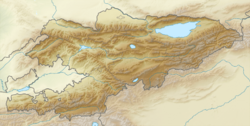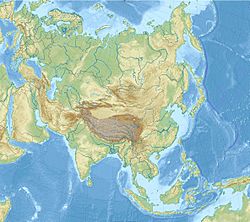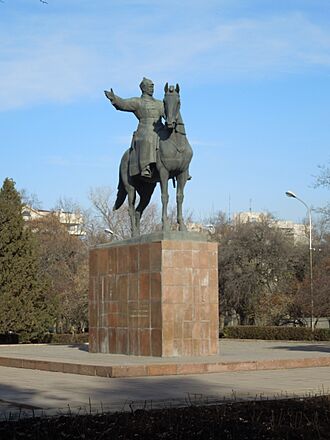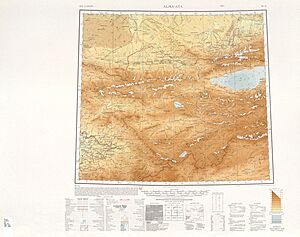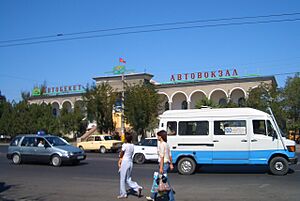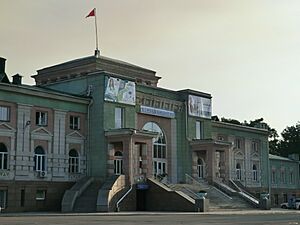Bishkek facts for kids
Quick facts for kids
Bishkek
Бишкек
|
|||
|---|---|---|---|
| Kyrgyz transcription(s) | |||
| • ISO 9 | Biškek | ||
| • BGN/PCGN | Bishkek | ||
| • ALA-LC | Bishkek | ||
|
Clockwise from top: view from Bishkek south towards the Kyrgyz Ala-Too Range; Bishkek Central Mosque; Residential Area of the City; Victory Square and Bishkek City Hall
|
|||
|
|||
| Country | |||
| City | Bishkek | ||
| Founded | 1825 | ||
| District |
Districts
Birinchi May
Lenin Oktyabr Sverdlov |
||
| Area | |||
| • Total | 386.0 km2 (149.0 sq mi) | ||
| Elevation | 800 m (2,600 ft) | ||
| Population
(2023)
|
|||
| • Total | 1,145,044 | ||
| • Density | 2,966.4/km2 (7,683.0/sq mi) | ||
| Time zone | UTC+06:00 (Kyrgyzstan Time) | ||
| • Summer (DST) | (Not Observed) | ||
| Postal code |
720000–720085
|
||
| Area code(s) | (+996) 312 | ||
| Vehicle registration | B, E, 01 | ||
| HDI (2021) | 0.739 high · 1st |
||
Bishkek is the capital and largest city of Kyrgyzstan. It was once known as Frunze and before that Pishpek. Bishkek is also the main city of the Chüy Region. It is located near the border with Kazakhstan. As of 2021, over 1 million people live in Bishkek. It is the most important and biggest city in Kyrgyzstan. About 17% of all people in the country live in its wider city area.
In 1825, the Khanate of Kokand built a fort called Pishpek. This fort helped them control trade routes and collect taxes from local Kyrgyz tribes. On September 4, 1860, Russian forces destroyed the fort. Today, you can still find the ruins of the fort north of Jibek jolu Street. In 1868, a Russian settlement was built on the same spot, keeping the name Pishpek.
In 1925, Pishpek became the capital of the Kara-Kirghiz Autonomous Oblast. In 1926, the city's name was changed to Frunze. This was to honor Mikhail Frunze, a military leader born there. Frunze became the capital of the Kirghiz Soviet Socialist Republic in 1936. In 1991, after Kyrgyzstan became independent, the capital's name was changed back to Bishkek.
Bishkek is about 800 meters (2,600 feet) above sea level. It sits at the northern edge of the Kyrgyz Ala-Too Range. These mountains are part of the Tian Shan range and can reach heights of 4,895 meters (16,060 feet). North of the city, there are flat, fertile lands that stretch into Kazakhstan. The Chüy River flows through most of this area. Bishkek is connected to the Turkestan–Siberia Railway by a special train line.
Bishkek has wide streets and public buildings made of marble. Many Soviet-style apartment buildings are also found here. There are also many smaller, private homes, especially outside the city center. The streets are laid out in a grid pattern. Most streets have narrow water channels on both sides. These channels water the trees that provide shade in the hot summers.
Contents
What's in a Name?
The name Bishkek is thought to come from a word for a paddle. This paddle is used to churn milk when making a fermented drink called kumis.
The city hall's official website shares a story about the name. A hero's pregnant wife lost her kumis paddle. While looking for it, she gave birth to a boy. She named him Bishkek. Bishkek grew up to be an important person. After he died, he was buried on a small hill near the Alamüdün River. A tombstone was put there. Travelers from the 17th and 18th centuries saw and wrote about this building.
City's Story
Early Times
Bishkek was first a resting place for traders on the Silk Road. This ancient trade route went through the Tian Shan mountains. In 1825, the khan of Kokand built a mud fort here. This fort was called Pishpek. Later, in 1844, the forces of Ormon Khan briefly took control of the fort.
Russian Influence
In 1860, Imperial Russia took over the area. Russian military forces destroyed the fort. Colonel Apollon Zimmermann then rebuilt the town on the same spot. The Russian government encouraged Russian farmers to move here from 1877 onwards. They gave them good land to farm.
Soviet Era Changes
In 1926, the city became the capital of the new Kirghiz ASSR. It was renamed Frunze after Mikhail Frunze. He was a close friend of Lenin and played a big part in the Russian Revolution and the Russian Civil War.
Becoming Independent
The early 1990s were a busy time for Bishkek. In June 1990, there were ethnic conflicts in southern Kyrgyzstan. A state of emergency was declared in Bishkek to prevent problems from spreading. On February 5, 1991, the city was renamed Bishkek. Later that year, Kyrgyzstan became an independent country. Before independence, most people in Bishkek were ethnic Russians. By 2004, Russians made up about 20% of the city's population. In 2011, this was about 7–8%.
Bishkek is the main financial center of Kyrgyzstan. All 21 of the country's commercial banks have their main offices here. During the Soviet era, many factories were in the city. Most of them have closed or are much smaller now. One of the biggest places for jobs today is the Dordoy Bazaar. This is a large outdoor market where many goods from China are sold to other countries.
City Layout and Sights
Bishkek itself is a fairly new city. However, the area around it has interesting sites from ancient times. These include places from the Greco-Buddhist period and the time of Central Asian kingdoms.
Getting Around the City
The central part of Bishkek is laid out like a checkerboard. The main street runs from east to west and is called Chüy Avenue. Many important government buildings and universities are on or near this street. The western part of the avenue is called Deng Xiaoping Avenue.
The main north-south street is Yusup Abdrakhmanov Street. People often still call it Sovietskaya Street. Many big shopping centers are along this street. To the north, it leads to the Dordoy Bazaar.
Erkindik ("Freedom") Boulevard runs north to south. It goes from the main train station (Bishkek II) to a museum area and sculpture park. It then continues north towards the Ministry of Foreign Affairs.
Another important east-west street is Jibek Jolu, which means 'Silk Road'. It runs about 2 kilometers (1.2 miles) north of Chüy Avenue. It is part of the main east-west road for the Chüy Region. Both the eastern and western bus stations are on Jibek Jolu.
There is a Roman Catholic church at ul. Vasiljeva 197. It is the only Catholic church in Kyrgyzstan.
The largest football stadium in Kyrgyzstan, named after Dolon Omurzakov, is near the city center.
Places to Visit in the City Center
- Kyrgyz State Historical Museum: Located in Ala-Too Square, the city's main square.
- State Museum of Applied Arts: Shows examples of traditional Kyrgyz handicrafts.
- Frunze House Museum: A museum about Mikhail Frunze.
- Statue of Ivan Panfilov: Found in the park near the White House.
- Mikhail Frunze Statue: An equestrian (horseback) statue in a large park across from the train station.
- The train station: Built in 1946.
- The White House: The main government building, a large seven-story marble building.
- Ala-Too Square: Has an independence monument where you can watch the changing of the guards.
- Osh Bazaar: West of the city center, a big, colorful market for fresh produce.
- Kyrgyz National Philharmonic: A concert hall.
Outside the City Center
The Dordoy Bazaar is a huge market on the north-eastern edge of the city. It is a major place for buying and selling goods.
Nature Near the City
The Kyrgyz Ala-Too mountain range is about 40 kilometers (25 miles) away. It offers a beautiful view behind the city. The Ala Archa National Park is only a 30 to 45-minute drive away. It's a great place to explore nature.
Distances to Other Cities
Bishkek is about 300 km (186 miles) from Osh, Kyrgyzstan's second-largest city. The closest large city is Almaty in Kazakhstan, which is 190 km (118 miles) to the east. It is also 470 km (292 miles) from Tashkent (Uzbekistan) and 680 km (423 miles) from Dushanbe (Tajikistan).
Weather in Bishkek
Bishkek has a climate with hot summers and cold winters. The average temperature in winter is below freezing. The city gets about 440 mm (17 inches) of rain each year. In July, the average high temperature is about 31°C (88°F). In January, it's about 3°C (37°F). Summers are usually dry, but sometimes there are thunderstorms. The mountains to the south protect the city from bad weather. In winter, there can be light snowstorms and a lot of fog.
| Climate data for Bishkek (1991–2020, extremes 1936–present) | |||||||||||||
|---|---|---|---|---|---|---|---|---|---|---|---|---|---|
| Month | Jan | Feb | Mar | Apr | May | Jun | Jul | Aug | Sep | Oct | Nov | Dec | Year |
| Record high °C (°F) | 20.0 (68.0) |
25.4 (77.7) |
30.5 (86.9) |
34.7 (94.5) |
36.7 (98.1) |
40.9 (105.6) |
42.1 (107.8) |
39.7 (103.5) |
37.1 (98.8) |
34.2 (93.6) |
29.8 (85.6) |
23.7 (74.7) |
42.1 (107.8) |
| Mean daily maximum °C (°F) | 2.9 (37.2) |
5.1 (41.2) |
12.1 (53.8) |
18.7 (65.7) |
24.1 (75.4) |
29.5 (85.1) |
32.4 (90.3) |
31.4 (88.5) |
25.6 (78.1) |
18.5 (65.3) |
10.3 (50.5) |
4.6 (40.3) |
17.9 (64.2) |
| Daily mean °C (°F) | −2.7 (27.1) |
−0.5 (31.1) |
6.2 (43.2) |
12.8 (55.0) |
17.8 (64.0) |
22.9 (73.2) |
25.5 (77.9) |
24.2 (75.6) |
18.7 (65.7) |
11.6 (52.9) |
4.2 (39.6) |
−1.1 (30.0) |
11.6 (52.9) |
| Mean daily minimum °C (°F) | −7.1 (19.2) |
−4.9 (23.2) |
1.0 (33.8) |
6.9 (44.4) |
11.2 (52.2) |
16.1 (61.0) |
18.4 (65.1) |
16.9 (62.4) |
11.7 (53.1) |
5.6 (42.1) |
−0.5 (31.1) |
−5.2 (22.6) |
5.8 (42.4) |
| Record low °C (°F) | −31.9 (−25.4) |
−34 (−29) |
−21.8 (−7.2) |
−12.3 (9.9) |
−5.5 (22.1) |
2.4 (36.3) |
7.4 (45.3) |
5.1 (41.2) |
−2.8 (27.0) |
−11.2 (11.8) |
−32.2 (−26.0) |
−29.1 (−20.4) |
−34 (−29) |
| Average precipitation mm (inches) | 28 (1.1) |
36 (1.4) |
48 (1.9) |
71 (2.8) |
59 (2.3) |
34 (1.3) |
19 (0.7) |
15 (0.6) |
18 (0.7) |
37 (1.5) |
45 (1.8) |
37 (1.5) |
455 (17.9) |
| Average extreme snow depth cm (inches) | 5 (2.0) |
3 (1.2) |
1 (0.4) |
0 (0) |
0 (0) |
0 (0) |
0 (0) |
0 (0) |
0 (0) |
0 (0) |
1 (0.4) |
3 (1.2) |
5 (2.0) |
| Average rainy days | 3 | 5 | 9 | 12 | 13 | 10 | 10 | 6 | 6 | 8 | 7 | 4 | 93 |
| Average snowy days | 9 | 9 | 5 | 2 | 0.3 | 0 | 0 | 0 | 0 | 1 | 4 | 7 | 37 |
| Average relative humidity (%) | 75 | 75 | 71 | 63 | 60 | 50 | 46 | 45 | 48 | 62 | 70 | 75 | 62 |
| Mean monthly sunshine hours | 137 | 128 | 153 | 194 | 261 | 306 | 332 | 317 | 264 | 196 | 144 | 114 | 2,546 |
| Source 1: Pogoda.ru.net | |||||||||||||
| Source 2: NOAA (sun, 1961–1990) | |||||||||||||
People of Bishkek
Bishkek is the most populated city in Kyrgyzstan. In 2021, its population was estimated at over 1 million people. For many years, people of European descent, like Russians and Ukrainians, made up most of the city's population. In 1970, only 12.3% of the people in Frunze (Bishkek) were ethnic Kyrgyz. Now, Bishkek is mainly a Kyrgyz city, with 75% of its residents being Kyrgyz. About 15% are people of European descent. Even so, Russian is still the main language spoken, and Kyrgyz is used less, especially by younger people.
| Historical populations in Bishkek | ||||||||||||||||||||||||||||||||||||||||||||||||||||||||||||||||
|---|---|---|---|---|---|---|---|---|---|---|---|---|---|---|---|---|---|---|---|---|---|---|---|---|---|---|---|---|---|---|---|---|---|---|---|---|---|---|---|---|---|---|---|---|---|---|---|---|---|---|---|---|---|---|---|---|---|---|---|---|---|---|---|---|
|
|
|||||||||||||||||||||||||||||||||||||||||||||||||||||||||||||||
| Source: | ||||||||||||||||||||||||||||||||||||||||||||||||||||||||||||||||
Environment and Air Quality
In 2010, 14,400 tons of air pollutants were released in Bishkek. Air pollution in Bishkek is the highest among all cities in Kyrgyzstan. Sometimes, the pollution levels are much higher than allowed, especially in the city center. For example, levels of formaldehyde can be four times higher than safe limits.
Experts say that burning coal for heating, especially in informal settlements, causes a lot of pollution. Car exhaust and poor air circulation also contribute. The lack of air circulation is partly due to new tall buildings being built without proper planning. This has led to talks about stopping new high-rise construction.
The Kyrgyz State Agency of Hydrometeorology checks the air quality in Bishkek. There are seven stations that measure levels of sulfur dioxide, nitrogen oxides, formaldehyde, and ammonia.
Bishkek's Economy
Bishkek uses the som as its currency. The value of the som changes often, but in March 2023, it was about 85 som for one U.S. dollar. The economy in Bishkek is mostly based on farming. Farm products are sometimes traded in areas outside the city.
The streets of Bishkek often have vendors selling produce, like a big market. In the city center, there are more banks, stores, markets, and malls. Popular items to buy include handmade art, such as statues, carvings, paintings, and nature-inspired sculptures.
Homes in Bishkek
After the Soviet Union ended, housing in Bishkek changed a lot. Before, the government gave homes to people. Now, most homes are privately owned.
While single-family houses are becoming more popular, most people live in Soviet-era apartments. Even though Kyrgyzstan's economy is growing, new housing has been slow to build. Prices for homes doubled between 2001 and 2002. However, in the 2010s, many new homes were built. By 2021, over 246 construction companies were building homes, mostly fancy ones.
Many new buildings are in the southern part of the city. This area is close to an earthquake fault line. Many of these buildings are not strong enough for earthquakes, which is a big safety concern. Also, new buildings are taking over green spaces, sports fields, and playgrounds.
People who cannot afford homes in Bishkek often live in informal settlements on the city's edges. These settlements include Ak Jar, Ak Jol, and Archa Beshik. About 400,000 people, or 30% of Bishkek's population, live in these areas. Many of these settlements used to lack basic services like electricity and running water. Recently, the local government has been working to provide these services.
Culture and Fun
Bishkek is the most important city for culture in Kyrgyzstan. It has the National Library of the Kyrgyz Republic and many museums. These include the Kyrgyz State Historical Museum and the M. V. Frunze Museum. The national public TV and radio service, KTRK, is based in Bishkek. Newspapers in Bishkek include the English-language Bishkek Observer. There is also the world's only Dungan-language newspaper, Huimin bao, and the Russian-language Vecherniy Bishkek newspaper.
Beliefs and Religions
The largest religion in Bishkek is Sunni Islam. However, many Russians live in Kyrgyzstan, so there is also a large Russian Orthodox community. The Bishkek Central Mosque is one of the largest mosques in Central Asia. Bishkek is also home to the Roman Catholic Apostolic Administration of Kyrgyzstan.
Sports in the City
Bishkek has the Dolen Omurzakov Stadium. This is the biggest football stadium in Kyrgyzstan. It is the only one that can host international matches. Several Bishkek football teams play here, including six-time Kyrgyzstan League champions, Dordoi Bishkek. Other teams include Alga Bishkek and Ilbirs Bishkek.
Bishkek hosted the 2014 IIHF Challenge Cup of Asia – Division I for ice hockey.
Learning in Bishkek
Bishkek has many schools and universities, such as:
- American University of Central Asia
- Arabaev Kyrgyz State University
- International Atatürk-Alatoo University
- Kyrgyz-Russian Slavic University
- Kyrgyz State Medical Academy
- Kyrgyz State National University
- Kyrgyz Technical University
- Kyrgyz-Turkish Manas University
- University of Central Asia
There are also international schools for students whose families are from other countries:
- European School in Central Asia
- Oxford International School Bishkek
- Hope Academy of Bishkek
- QSI International School of Bishkek
- Silk Road International School
Getting Around Bishkek
Public Transportation
Public transport in Bishkek includes buses, electric trolleybuses, and public vans called marshrutka. The first bus and trolleybus services started in Bishkek in 1934 and 1951.
You can also find taxi cabs all over the city. The city is thinking about building a light rail system in the future.
Bus Stations
Bishkek has two main bus stations. The smaller, older Eastern Bus Station is mainly for minibuses. These go to places within or just outside the eastern suburbs, like Kant or Tokmok.
Long-distance buses and minibuses go to all parts of Kyrgyzstan from the newer, larger Western Bus Station. They also go to Almaty in Kazakhstan and Kashgar in China.
The Dordoy Bazaar also has places where minibuses leave frequently. These go to nearby towns and some buses take traders to Kazakhstan and Siberia.
Train Travel
As of 2007, the Bishkek-2 railway station has only a few trains each day. There is a popular three-day train service from Bishkek to Moscow.
Long-distance trains also go to Siberia (Novosibirsk and Novokuznetsk) and to Yekaterinburg in the Urals. These train trips are very slow. This is because of long stops at the border and the indirect routes. For example, a train from Bishkek to Yekaterinburg can take over 48 hours.
Air Travel
The city is served by Manas International Airport (FRU). It is about 25 kilometers (16 miles) north-west of the city center.
In 2001, the United States used Manas International Airport as an air base for its military operations. In 2003, Russia also set up its own air base (Kant Air Base) near Kant, about 20 kilometers (12 miles) east of Bishkek. This base used to be a big Soviet military pilot training school.
Famous People from Bishkek
- Chinghiz Aitmatov (1928–2008), a famous writer.
- Altynai Botoyarova (born 2004), a model.
- Talant Dujshebaev (born 1968), a handball coach and former player.
- Mikhail Frunze (1885–1925), the city was named after him for many years.
- Roza Otunbayeva (born 1950), the third president of Kyrgyzstan.
- Salizhan Sharipov (born 1964), the first astronaut from independent Kyrgyzstan.
- Valentina Shevchenko (born 1988), a kickboxer and UFC champion.
Sister Cities
Bishkek is connected with many cities around the world. These are called "sister cities" or "twin towns."
 Almaty, Kazakhstan (1994)
Almaty, Kazakhstan (1994) Ankara, Turkey (1992)
Ankara, Turkey (1992) Ashgabat, Turkmenistan (2018)
Ashgabat, Turkmenistan (2018) Colorado Springs, United States (1994)
Colorado Springs, United States (1994) Doha, Qatar (2014)
Doha, Qatar (2014) Gumi, South Korea (1991)
Gumi, South Korea (1991) İzmir, Turkey (1994)
İzmir, Turkey (1994) Kyiv, Ukraine (1997)
Kyiv, Ukraine (1997) Lianyungang, China (2015)
Lianyungang, China (2015) Astana, Kazakhstan (2011)
Astana, Kazakhstan (2011) Qazvin, Iran (2003)
Qazvin, Iran (2003) Samsun, Turkey
Samsun, Turkey Vassal, Belgium (2012)
Vassal, Belgium (2012) Shenzhen, China (2016)
Shenzhen, China (2016) Tashkent, Uzbekistan
Tashkent, Uzbekistan Tehran, Iran (1994)
Tehran, Iran (1994) Trabzon, Turkey (2014)
Trabzon, Turkey (2014) Ufa, Russia (2017)
Ufa, Russia (2017) Ürümqi, China (1993)
Ürümqi, China (1993) Wuhan, China (2016)
Wuhan, China (2016) Yinchuan, China (2000)
Yinchuan, China (2000)
Images for kids
See also
 In Spanish: Biskek para niños
In Spanish: Biskek para niños









